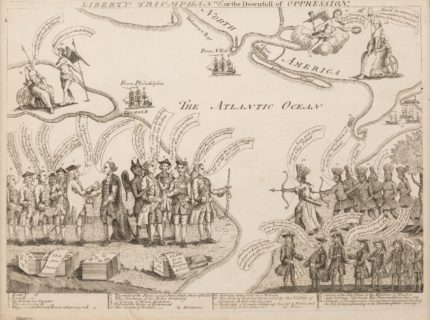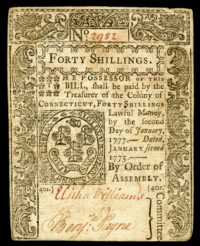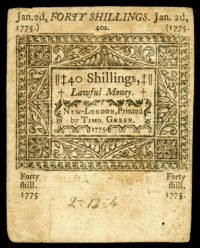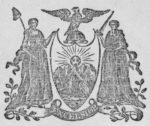An extremely rare print of one of the most significant political cartoons of the Revolutionary War is going under the hammer at Heritage Auctions on Saturday. “Liberty Triumphant: Or the Downfall of Oppression,” attributed to New York engraver Henry Dawkins, was published between December 27th, 1773 and April of 1774, so anywhere from 11 days to four months after the Sons of Liberty dressed up like Indians and dumped East India Company tea into Boston harbor in protest of the Tea Act. There are only six other copies known, all in institutions.

The rather busy and caption-filled cartoon shows British politicians & merchants in league with the devil, on the left side, and American colonists (seven dressed as Indians representing those at the Boston Tea Party) on the opposing right side (labeled Boston, New York and Delaware Bay).
Captions at the bottom serve as a “key” to the people and symbolic figures depicted. The men on the left side are, for the most part, representatives of the East India Company, along with Philadelphia Loyalist Dr. John Kearsley, Jr. The men in the lower right are colonial merchants who opposed the Tea Party, but deem it better to acquiesce, now that the deed is done. “The people have discovered our design to divide them, & we shall never be able to regain their confidence.” The Goddess of Liberty says “Behold the Ardor of my sons and let not their brave Actions be buried in Oblivion.” The lead Indian exclaims “We will secure our freedom, or die in the Attempt.”
Henry Dawkins was a colorful character, and by colorful I mean shady as all get out. Born in England, he set up shop as an engraver in New York. After printing the seminal cartoon celebrating the Boston Tea Party, he was contracted by the New York Provincial Congress to engrave plates for the new Continental currency. Then something went awry and he found himself doing a stint in the city jail for reasons that have been lost in the mists of time, but given his future shenanigans it’s likely an extra-legal use of his engraving prowess was involved.
While he was incarcerated, one Israel Youngs was a frequent visitor, and when Dawkins was released in early 1776, Youngs invited him to visit the duplex home he shared with his brother Isaac in Huntington, Long Island. According to Henry Dawkins’ testimony to a New York Provincial Congress committee in May 1776, Israel repeatedly entreated him to engrave fresh plates so they could profit from the brisk business in counterfeit cash that had sprung up since the Colonies had begun to print their own paper money to raise funds for the war effort.
British authorities and Loyalists made a point of spreading counterfeit bills as a form of economic sabotage. It worked, too. The value of Continental bills cratered and almost a century would pass before the United States issued paper currency again in 1861 under pressure from an even more brutal war.
 His English birth thus cast even more suspicion on Dawkins’ activities at the Youngs house. Dawkins had chests of his specialized engraving tools at the home, yet claimed to be supporting himself on past income. One of the Youngs had tried to buy paper in Huntington only to find that it “would not do.” Isaac was overheard telling someone that he would pay off all his debts that summer in Continental Currency. Israel Youngs was the only person allowed to bring wood up to Dawkins’ attic room. It didn’t take much for such glaringly obvious clues to lead people to the glaringly obvious conclusion. Another English-born man, Charles Friend, reported them for counterfeiting and in May of 1776 Captain Jeremiah Wool of the New York militia arrested Dawkins, the Youngs and their kinsman Isaac Ketchan.
His English birth thus cast even more suspicion on Dawkins’ activities at the Youngs house. Dawkins had chests of his specialized engraving tools at the home, yet claimed to be supporting himself on past income. One of the Youngs had tried to buy paper in Huntington only to find that it “would not do.” Isaac was overheard telling someone that he would pay off all his debts that summer in Continental Currency. Israel Youngs was the only person allowed to bring wood up to Dawkins’ attic room. It didn’t take much for such glaringly obvious clues to lead people to the glaringly obvious conclusion. Another English-born man, Charles Friend, reported them for counterfeiting and in May of 1776 Captain Jeremiah Wool of the New York militia arrested Dawkins, the Youngs and their kinsman Isaac Ketchan.
Dawkins confessed all. He fingered Israel Youngs as the ringleader, claiming Israel had solicited him to create plates of 40-shilling Connecticut bills, thirty-dollar Continental currency and 42-shilling Massachusetts bills. The Connecticut and Massachusetts ones were printed on a rolling press hidden in a garret and signed in red carmine ink by Israel Youngs. The Continental bills were more complicated to produce because they required special paper that could only be acquired with great difficulty in Philadelphia and Dawkins said he never knew if they’d manage to secure that paper.
 The New York Provincial Congress committee convicted Dawkins and in June 1776 he was sentenced to pay a hefty fine and imprisonment in an Albany jail. The Youngs brothers and Isaac Ketcham (tasked with buying the paper in Philly) were also convicted. Israel Youngs, who denied all knowledge of the plot and his brother were sentenced to jail in Litchfield, Connecticut, but Israel only served a few months because he bribed a jailer and escaped in November of 1776. He tried to go back to Long Island but everyone hated his counterfeiting ass now, so he had to move to New Jersey.
The New York Provincial Congress committee convicted Dawkins and in June 1776 he was sentenced to pay a hefty fine and imprisonment in an Albany jail. The Youngs brothers and Isaac Ketcham (tasked with buying the paper in Philly) were also convicted. Israel Youngs, who denied all knowledge of the plot and his brother were sentenced to jail in Litchfield, Connecticut, but Israel only served a few months because he bribed a jailer and escaped in November of 1776. He tried to go back to Long Island but everyone hated his counterfeiting ass now, so he had to move to New Jersey.
Henry Dawkins was not so fortunate in his jailers. From his prison in White Plains (Albany fell through), he sent a petition dated October 19th, 1776, to the Provincial Congress literally begging for death.
MAY IT PLEASE YOUR HONOURS: The subscriber, humbly relying on the known goodness and humanity of this honourable House, begs leave to lay his complaint before them, which is briefly as follows:
That your petitioner was about six months past taken upon Long-Island for a trespass of which this House is thoroughly acquainted, as by the instigation of Israel Youngs he was led away to perform an action of which he has already sincerely repented. And as your petitioner was torn away from his only son, who is left among strangers, without any one to support or protect him during the inclemency of the approaching winter; as his unhappy father hath since the first day of his being taken had but one shirt and one pair of stockings to shift himself, and as he hath been afflicted during his imprisonment at the White-Plains with the worst of enemies — hunger, and the nauseous stench of a small room where sometimes twenty persons were confined together, which hath introduced a sickness on your distressed subscriber, which, with the fatigue of travelling, hath reduced your unhappy petitioner to a state of despondency; — he therefore, being already weary of such a miserable life as his misconduct hath thrown him into, humbly begs for a termination of his sorrows by a death to be inflicted in what manner the honourable House may think fit. The kind compliance of this honourable House will ever lay an obligation on your Honours’ distressed, humble servant,
HENRY DAWKINS.
 They did not accede to his request. It’s not clear exactly when he was released, but released he was because, believe it or not, in early 1778 he was back on his grind, working for the same government that had convicted him of counterfeiting. Henry Dawkins engraved the first official coat of arms of the State of New York, the same design that would be printed on the reverse of New York’s issue of the 1882 National Bank Note.
They did not accede to his request. It’s not clear exactly when he was released, but released he was because, believe it or not, in early 1778 he was back on his grind, working for the same government that had convicted him of counterfeiting. Henry Dawkins engraved the first official coat of arms of the State of New York, the same design that would be printed on the reverse of New York’s issue of the 1882 National Bank Note.